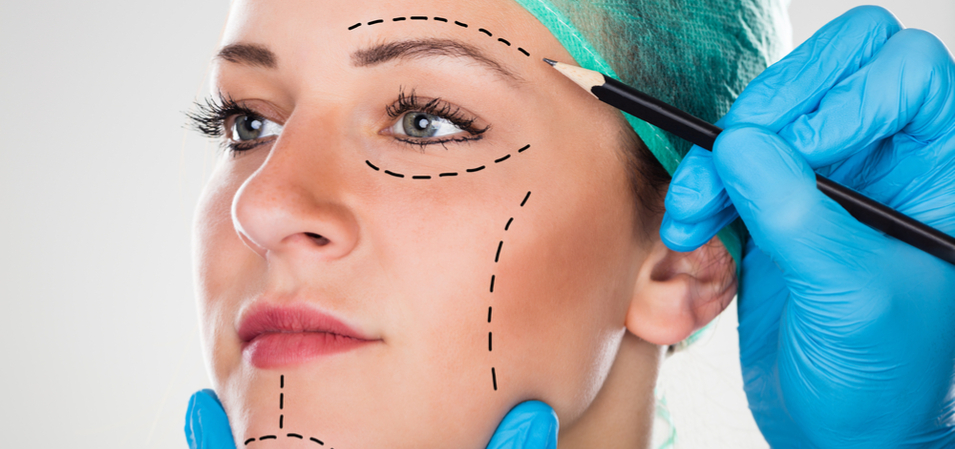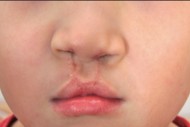
Think about the following questions.
1. Do you know of anyone who has ever had surgery to alter his or her appearance? How well did it work?
2. Should people have surgery simply to improve their looks? Why or why not?
3. If you could change one thing about your appearance, what would it be and why?
VOCABULARY PREVIEW
Match each New Academic Word List(NAWL) word with the correct definition.
- upwards (of)
- tremendous _____
- socially _____
- converge _____
- economically _____
- clinic _____
- a. huge, immense
- b. more than
- c. a small healthcare facility
- d. to come together
- e. of or relating to a cultural norm
- f. in a manner relating to the production, buying, and selling of goods and services
A SURGE IN COSMETIC SURGERY

As it becomes more socially acceptable, we are witnessing tremendous increase in cosmetic1 plastic surgery. According to 2019 figures from the International Society for Aesthetic Plastic Surgery (ISAPS), more than twenty-five million cosmetic surgical and nonsurgical procedures were performed worldwide-a figure expected to continue rising. The US still has the most procedures overall, with Brazil gaining ground steadily. But South Korea tops the list in terms of per capita2 procedures. Figures vary, but polls place the rate between twenty and thirty-five percent of the population. One BBC poll reported upwards of fifty percent of South Korean women in their twenties have "had some work done." Globally, the top three surgical procedures for women were breast enlargement, liposuction, and eyelid surgery, while the top three surgical procedures for men were nose reshaping, eyelid surgery, and liposuction.
Liposuction is the removal of excess fat from beneath the skin. The doctor inserts a small tube into the skin, and a vacuum-like machine removes the fat. People are usually given general anesthesia3 for liposuction or local anesthesia if they are only having one area done. Many doctors insist that liposuction is not a cure for obesity. It should be used when diet and exercise do not reduce fat in certain "trouble spots" of the body. That is why the ideal candidate is physically fit, exercises regularly, and is not more than twenty pounds overweight. Liposuction can cost from $2,000 to more than $10,000, depending on the number of areas treated, the type of area treated, and the amount of fat to be removed from those areas. The procedure may be performed on the abdomen4, hips, thighs, calves, arms, buttocks, back, neck, or face.
In addition to the three most popular surgical procedures, the number-one nonsurgical procedure favored by both women and men is Botox injections. Botox is a drug made from a toxins5 produced by the same bacteria that cause botulism (a type of food poisoning). Botox injections temporarily freeze the muscles that cause wrinkles, giving the skin a smoother look for about four months. These injections are becoming increasingly popular, with some people even throwing "Botox parties." The party is a social gathering at which a doctor injects the participants with Botox. These treatments typically cost $300 to $500. The ISAPS's 2019 study counted 6.2 million Botox injections administered around the world.
There are many reasons why the number of cosmetic surgeries is increasing. As populations are getting older, the desire to look younger is raising the demand for all cosmetic procedures. There is a widespread—and possibly justified-belief that looking younger helps a person stay competitive in the workplace. Moreover, with improvements in medicine and technology, surgeons can perform procedures with less scarring6 and in a shorter period of time, which makes these operations more appealing.
Many customers are also becoming better-informed about procedures and the precautions7 they must take before having cosmetic surgery, and this leads to better and safer results. These precautions include making sure that the doctor is a board-certified surgeon. There are many websites where the public can get information about plastic surgery, including risks, lists of qualified surgeons, and "before" and "after" photos, increasing confidence in the procedures.
There are also financial factors behind the trend. In economically advanced countries like the US and South Korea, increased competition has brought prices down and overall volume up. Meanwhile, emerging economies like Brazil and China are producing new middle and upper-middle classes with higher disposable incomes8. In some cases, these shifts are converging. South Korea, for instance, is a major destination for "plastic surgery tourism" originating elsewhere in East Asia. China's new elite takes advantage of the advanced medical technology at many private Korean clinics, while Japanese tourists are mainly attracted by the relatively low prices.
New Academic Word List
- cosmetic 1 : adj. used or done in order to improve a person's appearance
- per capita 2 : adj. per person; divided by total population
- anesthesia3 : n. loss of feeling in a person's body or part of the body through the use of drugs
- abdomen 4 : n. the stomach area
- toxin 5 : n. a poisonous substance
- scarring 6 : n. the marks on the body left by operations
- precaution 7 : n. a step taken beforehand to improve safety
- disposable income 8 : n. income that is available to be used (i.e., after taxes and other expenses)
READING COMPREHENSION
A ‣ Mark each statement as true (T) or false (F) according to the reading.
- More cosmetic procedures are performed in the US than in any other country.
- True
- False
- Liposuction was the most popular cosmetic surgery for both men and women.
- True
- False
- Botox injections permanently remove wrinkles.
- True
- False
- New middle-class populations are adding to the demand for plastic surgery.
- True
- False
- Korea, Japan, and China are all popular destinations for "plastic surgery tourism."
- True
- False
B ‣ Choose the best answer according to the reading.
- What is the main idea of the reading?
- a. Cosmetic plastic surgery is getting more popular around the world.
- b. Plastic surgery is a prime example of American cultural influence.
- c. South Korea is the undisputed center of plastic surgery in East Asia.
- d. Liposuction and Botox injections are two very popular procedures.
- What is the main purpose of paragraph 3?
- a. To define the different types of cosmetic surgery
- b. To explain the different effects of botulism bacteria
- c. To argue that men are just as likely to worry about their looks as women
- d. To provide information about the most popular non-surgical procedure
- Which of the following is NOT mentioned as a reason plastic surgery is more common now?
- a. Populations are aging.
- b. Technologies have advanced.
- c. Looks are more important.
- d. Consumers are better-informed.
- We can guess from paragraph 6 that _____.
- a. plastic surgery in Japan is relatively expensive
- b. East Asians are overly concerned with their looks
- c. the US and Korea view each other as competitors
- d. Brazil and China have especially old populations
C ‣ Find the correct numbers in the reading and write them on the lines.
- _____ : the number of cosmetic procedures performed in 2019
- _____ : the percentage of South Korean women in their twenties who have had procedures done
- _____ : the lowest amount you can expect to pay for liposuction
SUMMARY
Fill in the blanks with the phrases in the box.
- temporarily paralyze
- seriously overweight
- made from bacteria
- remove excess fat
- can afford
- aging populations
|
Liposuction
|
|
Botox
|
|
Reasons for Growth
|
VOCABULARY PRACTICE
Fill in the blanks with the words in the box. Change the form if necessary.
- clinic
- converge
- economically
- socially
- tremendous
- upwards
- Alcohol sales tend to go up during _____ difficult times.
- TV and the internet are _____ in new media formats like YouTube.
- Dr. Casey grew tired of working at a huge hospital and opened her own _____ .
- Consumers prefer companies that try to be _____ responsible-by reducing their environmental impact, for example.
- Jerry was wading in the sea when a(n) _____ wave crashed into him, knocking him down.
- The stadium is packed today, with _____ of 100,000 fans.
SUPPLEMENTAL READING
Smiling Around the World

Plastic surgery can be helpful for correcting birth defects in children. An organization called Operation Smile provides reconstructive plastic surgery for poor children all over the world. Reconstructive surgery is performed on abnormal parts of the body caused by birth defects, developmental abnormalities, injuries, infections, tumors, or diseases. The surgery is generally performed to improve function but may also be performed to give a child a more normal appearance.
Operation Smile was founded in 1982 by American plastic surgeon Dr. William Magee, Jr. and his wife Kathleen, a nurse and clinical social worker. The couple traveled to the Philippines with a group of medical volunteers to repair children's cleft lips and cleft palates, common disorders affecting the shape of the mouth. The Magees saw a need, and Operation Smile was born. The goal of the charity is to improve the lives of children by improving their appearance, building up their self-esteem, and restoring their dignity.
The organization provides free reconstructive surgeries to children born with facial deformities. Doctors and nurses from around the world volunteer two weeks of their time to a medical mission. During a typical international medical mission, between 300 and 500 children receive full medical assessments, and one hundred to 150 children are surgically treated. Since 1982, more than 220,000 children and young adults with facial deformities have been treated by thousands of volunteers worldwide. In addition, thousands of medical professionals have been trained globally. Operation Smile currently operates in sixty countries and has over 4,000 medical volunteers ready to donate their time and talents.
Fill in the blanks with information from the reading.
- Operation Smile provides surgeries both to improve function and to provide children with a(n) _____ .
- Volunteers' trips for Operation Smile last for _____ .
- The organization is active in _____ countries around the world.

Leave a comment
Load more